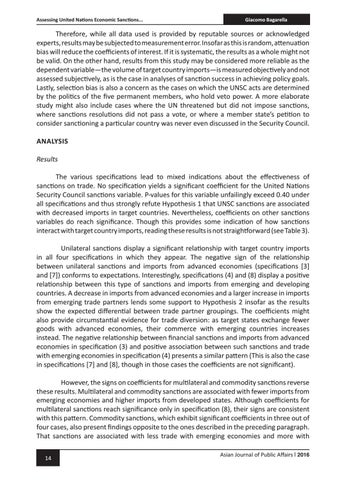Assessing United Nations Economic Sanctions...
Giacomo Bagarella
Therefore, while all data used is provided by reputable sources or acknowledged experts, results may be subjected to measurement error. Insofar as this is random, attenuation bias will reduce the coefficients of interest. If it is systematic, the results as a whole might not be valid. On the other hand, results from this study may be considered more reliable as the dependent variable—the volume of target country imports—is measured objectively and not assessed subjectively, as is the case in analyses of sanction success in achieving policy goals. Lastly, selection bias is also a concern as the cases on which the UNSC acts are determined by the politics of the five permanent members, who hold veto power. A more elaborate study might also include cases where the UN threatened but did not impose sanctions, where sanctions resolutions did not pass a vote, or where a member state’s petition to consider sanctioning a particular country was never even discussed in the Security Council. ANALYSIS Results The various specifications lead to mixed indications about the effectiveness of sanctions on trade. No specification yields a significant coefficient for the United Nations Security Council sanctions variable. P-values for this variable unfailingly exceed 0.40 under all specifications and thus strongly refute Hypothesis 1 that UNSC sanctions are associated with decreased imports in target countries. Nevertheless, coefficients on other sanctions variables do reach significance. Though this provides some indication of how sanctions interact with target country imports, reading these results is not straightforward (see Table 3). Unilateral sanctions display a significant relationship with target country imports in all four specifications in which they appear. The negative sign of the relationship between unilateral sanctions and imports from advanced economies (specifications [3] and [7]) conforms to expectations. Interestingly, specifications (4) and (8) display a positive relationship between this type of sanctions and imports from emerging and developing countries. A decrease in imports from advanced economies and a larger increase in imports from emerging trade partners lends some support to Hypothesis 2 insofar as the results show the expected differential between trade partner groupings. The coefficients might also provide circumstantial evidence for trade diversion: as target states exchange fewer goods with advanced economies, their commerce with emerging countries increases instead. The negative relationship between financial sanctions and imports from advanced economies in specification (3) and positive association between such sanctions and trade with emerging economies in specification (4) presents a similar pattern (This is also the case in specifications [7] and [8], though in those cases the coefficients are not significant). However, the signs on coefficients for multilateral and commodity sanctions reverse these results. Multilateral and commodity sanctions are associated with fewer imports from emerging economies and higher imports from developed states. Although coefficients for multilateral sanctions reach significance only in specification (8), their signs are consistent with this pattern. Commodity sanctions, which exhibit significant coefficients in three out of four cases, also present findings opposite to the ones described in the preceding paragraph. That sanctions are associated with less trade with emerging economies and more with 14
Asian Journal of Public Affairs | 2016
